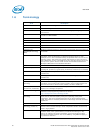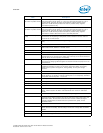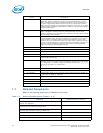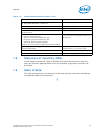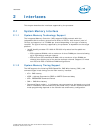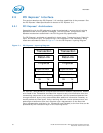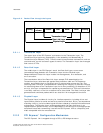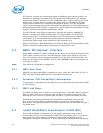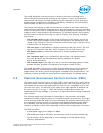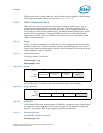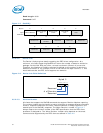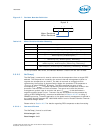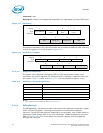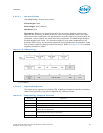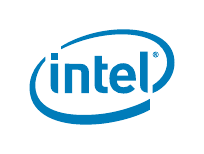
Interfaces
28 Intel® Xeon® Processor E5-1600 v2/E5-2600 v2 Product Families
Datasheet Volume One of Two
PCI Express* extends the configuration space to 4096 bytes per-device/function, as
compared to 256 bytes allowed by the Conventional PCI Specification. PCI Express*
configuration space is divided into a PCI-compatible region (which consists of the first
256 bytes of a logical device's configuration space) and an extended PCI Express*
region (which consists of the remaining configuration space). The PCI-compatible
region can be accessed using either the mechanisms defined in the PCI specification or
using the enhanced PCI Express* configuration access mechanism described in the PCI
Express* Enhanced Configuration Mechanism section.
The PCI Express* Host Bridge is required to translate the memory-mapped PCI
Express* configuration space accesses from the host processor to PCI Express*
configuration cycles. To maintain compatibility with PCI configuration addressing
mechanisms, it is recommended that system software access the enhanced
configuration space using 32-bit operations (32-bit aligned) only.
See the PCI Express* Base Specification for details of both the PCI-compatible and PCI
Express* Enhanced configuration mechanisms and transaction rules.
2.3 DMI2/PCI Express* Interface
Direct Media Interface 2 (DMI2) connects the processor to the Platform Controller Hub
(PCH). DMI2 is similar to a four-lane PCI Express* supporting a speed of 5 GT/s per
lane. This interface can be configured at power-on to serve as a x4 PCI Express* link
based on the setting of the SOCKET_ID[1:0] and FRMAGENT signal for processors not
connected to a PCH.
Note: Only DMI2 x4 configuration is supported.
2.3.1 DMI2 Error Flow
DMI2 can only generate SERR in response to errors, never SCI, SMI, MSI, PCI INT, or
GPE. Any DMI2 related SERR activity is associated with Device 0.
2.3.2 Processor/PCH Compatibility Assumptions
The processor is compatible with the PCH and is not compatible with any previous MCH
or ICH products.
2.3.3 DMI2 Link Down
The DMI2 link going down is a fatal, unrecoverable error. If the DMI2 data link goes to
data link down, after the link was up, then the DMI2 link hangs the system by not
allowing the link to retrain to prevent data corruption. This is controlled by the PCH.
Downstream transactions that had been successfully transmitted across the link
prior to the link going down may be processed as normal. No completions from
downstream, non-posted transactions are returned upstream over the DMI2 link after a
link down event.
2.4 Intel® QuickPath Interconnect (Intel® QPI)
The Intel® QuickPath Interconnect is a high speed, packetized, point-to-point
interconnect used in the 3rd Generation Intel® Core™ Processor Family. The narrow
high-speed links stitch together processors in distributed shared memory and
integrated I/O platform architecture. It offers much higher bandwidth with low latency.



